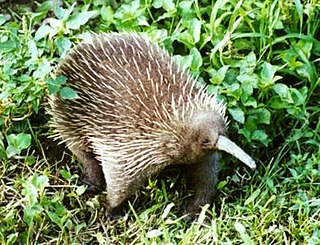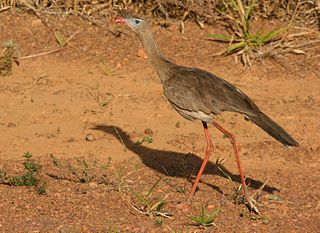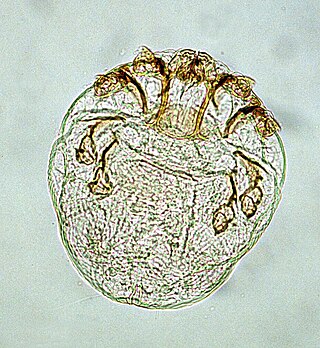
Symbion is a genus of commensal aquatic animals, less than 0.5 mm wide, found living attached to the mouthparts of cold-water lobsters. They have sac-like bodies, and three distinctly different forms in different parts of their two-stage life-cycle. They appear so different from other animals that they were assigned their own, new phylum Cycliophora shortly after they were discovered in 1995. This was the first new phylum of multicelled organism to be discovered since the Loricifera in 1983.
The beak, bill, or rostrum is an external anatomical structure found mostly in birds, but also in turtles, non-avian dinosaurs and a few mammals. A beak is used for pecking, grasping, and holding, preening, courtship, and feeding young. The terms beak and rostrum are also used to refer to a similar mouth part in some ornithischians, pterosaurs, cetaceans, dicynodonts, anuran tadpoles, monotremes, sirens, pufferfish, billfishes and cephalopods.

Mites are small arachnids. Mites span two large orders of arachnids, the Acariformes and the Parasitiformes, which were historically grouped together in the subclass Acari. However, most recent genetic analyses do not recover the two as each other's closest relative within Arachnida, rendering the group non-monophyletic. Most mites are tiny, less than 1 mm (0.04 in) in length, and have a simple, unsegmented body plan. The small size of most species makes them easily overlooked; some species live in water, many live in soil as decomposers, others live on plants, sometimes creating galls, while others are predators or parasites. This last type includes the commercially destructive Varroa parasite of honey bees, as well as scabies mites of humans. Most species are harmless to humans, but a few are associated with allergies or may transmit diseases.

Sarcoptes scabiei or the itch mite is a parasitic mite found in all parts of the world that burrows into skin and causes scabies. Humans become infested by Sarcoptes scabiei var. hominis; other mammals can be infested with different varieties of the mite. They include wild and domesticated dogs and cats, ungulates, wild boars, bovids, wombats, koalas, and great apes.

The long-beaked echidnas make up one of the two extant genera of echidnas: there are three extant species, all living in New Guinea. They are medium-sized, solitary mammals covered with coarse hair and spines made of keratin. They have short, strong limbs with large claws, and are powerful diggers. They forage in leaf litter on the forest floor, eating earthworms and insects.

Ascaris suum, also known as the large roundworm of pig, is a parasitic nematode that causes ascariasis in pigs. While roundworms in pigs and humans are today considered as two species with different hosts, cross-infection between humans and pigs is possible; some researchers have thus argued they are the same species. Ascariasis is associated with contact to pigs and pig manure in Denmark.

The short-beaked echidna, also known as the short-nosed echidna, is one of four living species of echidna and the only member of the genus Tachyglossus.

The yellow-legged buttonquail is a buttonquail, one of a small family of birds which resemble, but are unrelated to, the true quails. This family is peculiar in that the females are larger and more colourful than the males and are polyandrous.

Dicopomorpha echmepterygis is the smallest known insect and a species of parasitoid wasp of the family Mymaridae, which exhibits strong sexual dimorphism. The males are blind, apterous, and their body length is only 40% that of females. With a body length averaging 186 μm, males of D. echmepterygis have the shortest body length of all known insects. The measured body length of a female was 550 μm. Dicopomorpha echmepterygis males have relatively long legs and are dull grayish brown, with small heads that lack compound eyes, and unsegmented antennae. Females, however, have entirely black bodies with dusky brown legs and antennae. The antennae are twice as long as for males, and females have fully-functional wings that are narrowed slightly through the middle. The eggs and larvae of this parasitoid are considerably smaller than the adult.

The red-legged seriema, also known as the crested cariama and crested seriema, is a mostly predatory terrestrial bird in the seriema family (Cariamidae), included in the Gruiformes in the old paraphyletic circumscription but recently placed in a distinct order: Cariamiformes.

Trombiculidae, commonly referred to in North America as chiggers and in Britain as harvest mites, but also known as berry bugs, bush-mites, red bugs or scrub-itch mites, are a family of mites. Chiggers are often confused with jiggers – a type of flea. Several species of Trombiculidae in their larva stage bite their animal host and by embedding their mouthparts into the skin cause "intense irritation", or "a wheal, usually with severe itching and dermatitis". Humans, being animals, are possible hosts.
Karyolysus is a genus of coccidia. With the exception of K. sonomae whose vertebrate host is the yellow-legged frog, species in this genus only infect lizards of the genus Lacerta.
Aonchotheca forresteri is a parasitic nematode that infects the marsh rice rat in Florida. Occurring mainly in adults, it inhabits the stomach. It is much more common during the wet season, perhaps because its unknown intermediate host is an earthworm that only emerges when it rains. The worm was discovered in 1970 and formally described in 1987. Originally classified in the genus Capillaria, it was reclassified in Aonchotheca in 1999. A. forresteri is small and narrow-bodied, with a length of 13.8 to 19.4 mm in females and 6.8 to 9.2 mm in males. Similar species such as A. putorii differ in features of the alae and spicule, the size of the female, and the texture of the eggs.
Andreacarus voalavo is a parasitic mite found on the Malagasy rodent Voalavo gymnocaudus. First described in 2007, it is closely related to Andreacarus gymnuromys and Andreacarus eliurus, which are found on other Malagasy rodents. The length of the idiosoma, the main body, is 630 to 670 μm in females and 450 to 480 μm in males. Unlike A. eliurus, this species lacks distinct sternal glands between two lyrifissures on the lower part of the female body. The pilus dentilis, a sensory organ on the chelicera, is serrate, which distinguishes it from A. gymnuromys. Females of A. gymnuromys also have a less ornamented sternal shield and shorter setae (bristles) on the upperparts.

Brevipalpus phoenicis, also known as the false spider mite, red and black flat mite, and in Australia as the passionvine mite, is a species of mite in the family Tenuipalpidae. This species occurs globally, and is a serious pest to such crops as citrus, tea, papaya, guava and coffee, and can heavily damage numerous other crops. They are unique in having haploid females, a condition caused by a bacterium that change haploid males into females.

Myobia musculi is a type of fur mite which is found worldwide. It can infest mice and, rarely, other rodents. Like all mites the Myobia musculi mite has four pairs of legs but the first pair are very short, as an adaptation to grasping the hair shaft, giving the mite the appearance of having three pairs of legs. The second pair of legs end in empodia. Adult mites are approximately 160–180 μm wide; females are 400–500 μm long, and males are 280–320 μm long.

Knemidokoptes is a genus of parasitic mites in the family Epidermoptidae that infect the skin or feather follicles of birds, especially gallinaceous birds as well as parakeets and canaries. Infection commonly causes scaly lesions to form at the face or feet, which is known as knemidocoptiasis.

Notheia anomala is a macroalga in the family Notheiceae and the brown algae order Fucales. It is an obligate epiphyte of another brown algae, Hormosira banksii.

Kiwalges haastii is a species of New Zealand feather mite in the superfamily Analgoidea, known only from the great spotted kiwi, from which it derives its name.
Trombidium grandissimum, commonly known as the giant red velvet mite, is a species of mite in the genus Trombidium in the family Trombidiidae. This common mite is endemic to northern and central India, especially in the central plateau, and it primarily inhabits arid regions. T. grandissimum live on the ground and often hidden among soil, but is commonly seen during the rainy season or after recent rain events, and therefore has the nickname of "rain bug".















